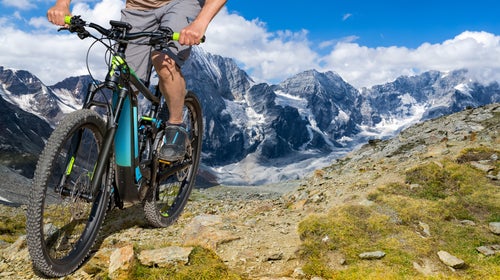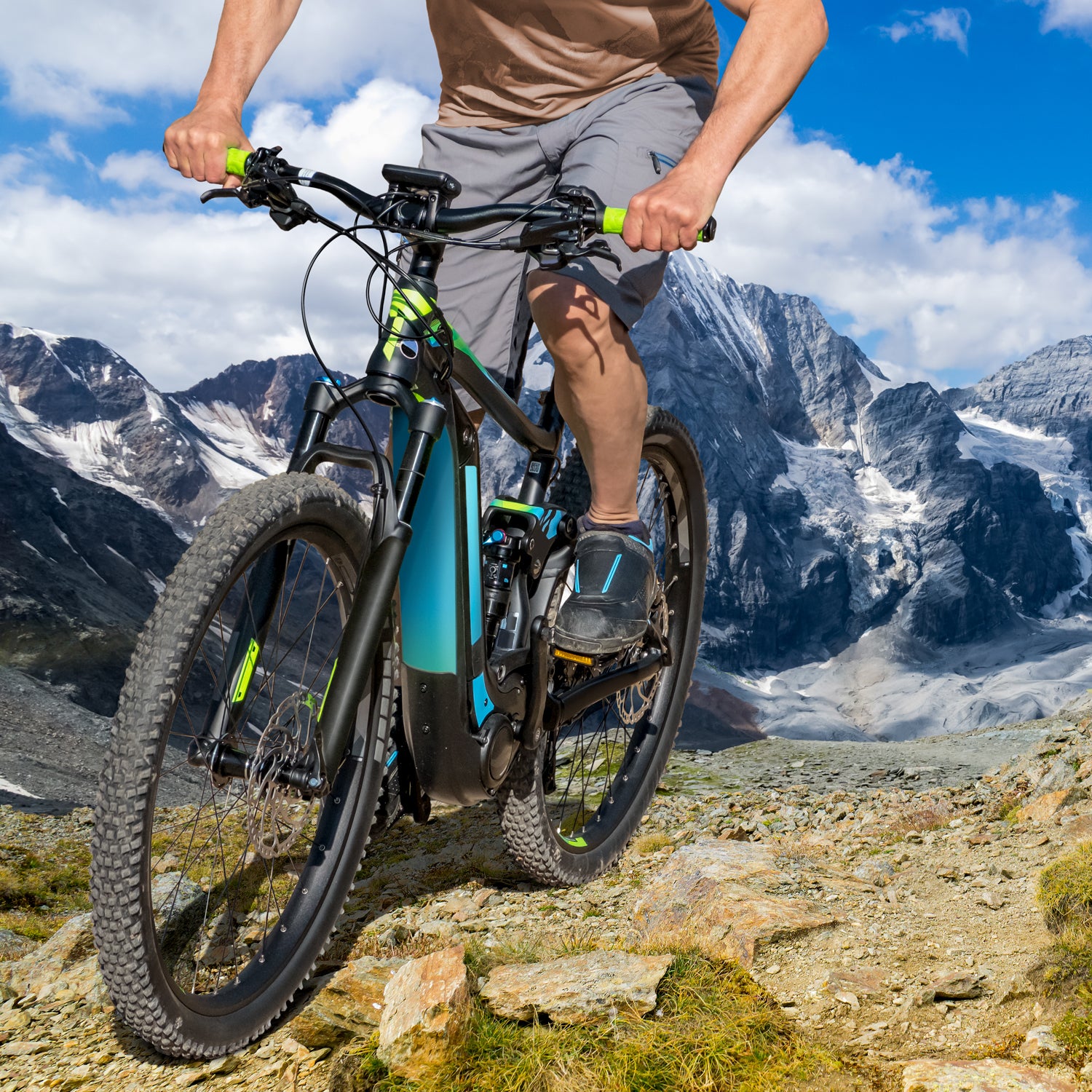Last month, the (UEC), the governing body that oversees the European championships in all cycling disciplines, announced that it’s adding racing categories for electric-assist road and mountain bikes. We could end the piece there, but there’s more to address with e-bikes than the fact that you forfeit the right to procreate if you race one.
E-bikes, if you don’t know, are traditional bikes outfitted with electric motors for extra power, adding watts to your pedal stroke. In the United States, we have three classes of e-bikes: Class 1 is an electric-assist bike with a governor that kicks in at 20 mph, Class 2 e-bikes come with a throttle and also idle down at 20 mph, and Class 3 versions allow for speeds up to 28 mph. Bike commuters in northern Europe have widely adopted all classes, and the push is on to do the same here. But along with commuting bikes come electric-assist road, mountain, and fat bikes. On the plus side, mass adoption of e-bikes could help save us from climate change by getting tens of thousands of cars off the roads. In the near-term, however, they have the ability to screw things up for human-powered cyclists.
Let’s start with mountain bikers, who face the most critical threat. Mountain bike trails are almost universally designed and built for a wide range of nonmotorized users, like horse packers, hikers, trail runners, dog walkers, birders, and off-road wheelchair users—you know, the rest of America. Without motors, mountain bikers already go uphill about 6 mph faster than most of those other users, 10 mph faster on the flats, and 20 mph faster on the downhills. The result is intermittent conflict between the fat-tire crowd and everyone else. E-bikes don’t go any faster downhill, but changing those first two dynamics with electric motors will only increase the hostility. And e-MTBs are out there, legally and illegally, as you read this.
Knowing this, the (IMBA) is asking e-MTBers to obey the laws as they work with land managers on a trail-by-trail basis (most trails that currently allow e-MTBs limit them to Class 1) and help coordinate some e-MTB test sites. But e-bike sales are outpacing IMBA’s efforts, and that means an increasing number of riders, whether intentionally or without knowing it, are zipping around on trails where they aren’t currently allowed. And to be clear, local rangers aren’t UCI-trained motorized-doping officials. The latest e-MTBs look a lot like human-powered MTBs. Rangers don’t have the budgets to station themselves at trailheads with sophisticated devices like those used by the UCI to detect illegal motors hidden in racers’ water bottles or down tubes. After a few incidents in which e-MTBers clip hikers on a climb—which seems inevitable—those land managers may shut the trails to all bikes. Beyond the user conflict and safety concerns, they’d have another justification: a Class 3 e-MTB would churn loam on a climb, increasing erosion. IMBA is too polite to say it, so I will: If you must ride an e-MTB, take your shame to some remote and throttle-friendly BLM lands where the moto crowd can laugh at you.
Forgetting mountain trails for a moment, there’s still an open debate whether e-bikes make sense on paved bike paths. Several states, including , California, and Colorado, have recently passed laws explicitly granting e-bikes that access. But bike paths are also multiuse nonmotorized networks. I ride such paths 200 days a year to get to work in Boulder, Colorado. They aren’t well suited for even fast pedaling, let alone the speeds gained by an electric assist. Boulder’s bike paths—the ones I ride—are notorious for broken collarbones. Typically, the entropy begins when a helmetless frat boy on a cruiser goes to hit his vape and hooks an oncoming handlebar from an unsuspecting commuter rounding the corner. Also dog leashes. Seasoned roadies know to soft-pedal on bike paths; meanwhile, some e-bike riders pass me during my commute going all out around 22 mph—7 mph over the speed limit. I have roughly zero faith in their bike-handling skills.
I lump e-MTBing in with helicopter- or snowmobile-assisted backcountry skiing and car-shuttle and lift-serviced mountain biking. It’s fun in the moment, but it’s inherently selfish, and it’s not exactly in keeping with the spirit of the sport.
The cycling advocacy group , funded in part by e-bike manufacturers, is in a position similar to IMBA’s, trying to figure out where e-bikes belong and where they don’t. At the same time, the group is helping to write legislation to get electric bikes legalized where they aren’t. More than 20 states in effect ban them, because, as motorized vehicles without vehicle identification numbers (VINs), they get caught up in bureaucracy; state transportation officials simply don’t know what to do with them. As for e-bike commuters obeying speed limits on bike paths, says Morgan Lommele, e-bike campaign manager for People For Bikes, “It falls on the person not to be an asshole.”
I appreciate the candor, but when it comes to mountain bike and bike path etiquette, when people are free to asshole it up, they usually do. Even I ride way too fast on the trail, and I know better.
Maybe I’m being overly dramatic and e-bikes won’t be as problematic as my worst-case-scenario mind would suggest, but let’s pull back for a moment and ask what is the point of an e-bike. If it’s to get to work without getting into your car, I commend the thought. But if you’re young and healthy and the electric motor is for recreation or fitness, you’re entirely missing the point of cycling. The raw thrill of descending technical or flowy trail on a mountain bike is honed only after you spend 80 percent of your time climbing to get there. I lump e-MTBing in with helicopter- or snowmobile-assisted backcountry skiing and car-shuttle and lift-serviced mountain biking. It’s fun in the moment, but it’s inherently selfish, and it’s not exactly in keeping with the spirit of the sport. As for electric-assist road biking, unless you have a disability like a torched knee, what exactly is the point? Road riding is 80 percent fitness, 10 percent descending, and another 10 percent sightseeing. E-biking is a Sunday drive.
And now we have e-bike racing, which began on a lark at the . It will likely catch on in Europe, where e-biking is well established—there’s talk of building an e-bike superhighway in the Netherlands—and electric-assist enduro/freeride mountain biking has taken root with those who cruise up paved roads with the motor boost before descending rough track. The UEC and the UCI are still figuring out the rules of what they’re calling—I’m not making this up—UEC Formula E-Bike. So far, they’ve decided that the motors will kick out when you aren’t pedaling—a throttle would be cheating, apparently—and the power will top out at 250 watts.
Those are interesting details to an engineer, perhaps, but how you actually race e-bikes is, as a friend says, an enigma wrapped in a mystery wrapped in a crispy tortilla. I’d rather not see it unraveled. Maybe it entails tactics like preserving one’s battery—thrilling stuff. And how long before the e-bike peloton learns how to cheat the system like the motorized dopers who are already getting caught in pro cycling? As has been proposed with biological dopers, better to make it an open class. I’m betting on the Russian team with the nuclear reactors in their saddlebags.
So, what should we do with e-bikes? As Michael Pollan might put it: Ride them to work, not too much on trails, never in races.


